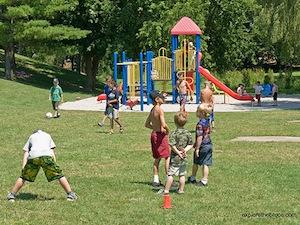How to keep kids safe in a toxic world
Photo of kids on a playground (Image by Flickr user Explore The Bruce (cc:by-sa))
This story was originally covered by PRI’s Living on Earth. For more, listen to the audio above.
Interview by Bruce Gellerman
Just as parents have to figure out a way to talk to their children about sex, ecologist, author, and cancer survivor Sandra Steingraber says that parents need to figure out a way to talk about the environmental crisis. At first, Steingraber told PRI’s Living on Earth that she tried to avoid the question of climate change. “But I ended up having to talk to my kids about climate change because my children asked me questions like: ‘momma is it supposed to be so hot?'” She told Living on Earth:
You know, this is like children hearing about sex on the playground — you want to make sure you have your own narrative story before they hear it from their peers – so in fact, there’s another big talk that parents now need to have with their kids.
“The environmental crisis is a crisis of family life because it takes away the ability of parents to keep their children safe from harm,” Steingraber says. Pollution, for example, can cause asthma and other long-term respiratory disorders. Steingraber says: “The parents who are in the emergency room with a child with an asthma attack, or standing in line at the pharmacy to get the prescription for the inhaler filled — we’re the ones paying the price for an energy policy that does not protect children’s health.”
Environmental policies in the United States have long pretended that children don’t exist, according to Steingraber. For example, regulations around radiation exposure were once based on a hypothetical “reference man,” who is a 150-pound, middle-aged white male. Steingraber says, “the special vulnerabilities of children to radiation exposure very early on, just as their brains are getting developed and so forth, wasn’t part of the calculation.”
“We are capable, as a society, of preventive action around an environmental threat to children,” she told Living on Earth. “But our ability to do that is really specific to threats that are visible.” In her new book, “Raising Elijah, Protecting our Children in an Age of Environmental Crisis,” Steingraber writes about the lack of governmental support she got when trying to protect her children from arsenic in playground equipment. When she found a rabid bat in her house, on the other hand, the government went to great legnths to keep her and her family safe.
Keeping kids safe, though, also means allowing them to be kids. “I’m not interested in turning children into atmospheric junior rangers who think that they have to protect the stratosphere against ozone depletion or too much carbon dioxide,” Steingraber says. “I want them to go outside and play and to develop a sense of natural wonder about this incredible world that we live in and it’s my job, as their mom, to be looking out for danger.”
Parents can’t keep their kids safe all the time, but Steingraber says there are things that parents can do. She told Living on Earth:
We can’t turn our houses into kind of latter day bomb shelters and keep all the chemicals that are in the air and the water and the food from entering our children’s bodies. The only solution has to be the forceful engagement of parents in the political system so that we demand a radical redesign of our energy, our agriculture, and our materials’ economy in a way that allow for the protection of children.
———————————————————–
Hosted by Steve Curwood, “Living on Earth” is an award-winning environmental news program that delves into the leading issues affecting the world we inhabit. More about “Living on Earth.”
